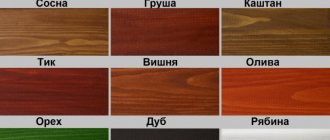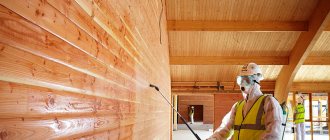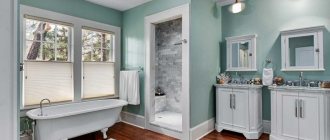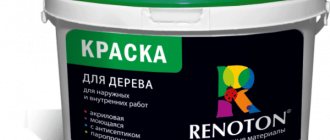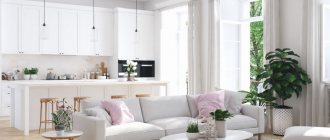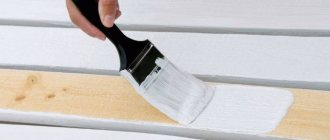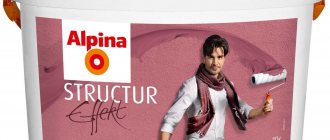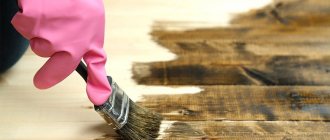Today, acrylic wood paint for exterior and interior decoration continues to be the most popular material. However, the options for using acrylic paint on wood do not end there. It is actively used in the manufacture and restoration of furniture, windows and various wood-based structures. This versatility is due to the numerous positive qualities that acrylic paint has. Let's look at them in more detail.
Properties of acrylic paints on wood
There are no traces left after painting.
- The tree structure remains.
- These paints have good water resistance.
- They are water based.
- Water solubility. Before the paint is completely dry, it can be removed with water.
- Temperature changes are not scary.
- Large variety of shades. There are matte and glossy.
- Does not fade in the sun. Because it contains resins.
- Does not fade on the surface.
- Thanks to the plasticizer in the composition, after drying the surface will not crack.
- Dries quickly due to the hardeners in the composition.
- The surface retains its appearance for a long time after painting.
- Eco-friendly composition.
Paints that differ in the type of top layer
Conventionally, such paint and varnish compositions are divided into glossy and matte. Each of them has its own characteristics.
Glossy surface composition
Glossy paints are a good coating for wooden furniture in small spaces (frankly speaking, this is exactly what I liked). After drying, the paintwork creates a reflective effect and, as a result, the space visually appears larger. This coating is easier to care for and is not afraid of wet cleaning.
Product with a matte top layer
Matte or semi-matte furniture paint is also available. Such options are appropriate for painting chairs or stools. After hardening, the coating becomes rough and non-slip, which is very convenient during use. Also, such surfaces look original if a living wood pattern is visible.
This video provides an overview of a type of wood paint that does not have a harmful toxic odor.
Types of paint for wood
- Matte and glossy.
- For interior and exterior work. Paints for external work have special additives in their composition. Thanks to them, the surface is not exposed to the sun and temperature changes. Otherwise the composition is identical. Acrylic paint for external work is also moisture resistant.
- There are acrylic paints that are suitable specifically for floors. They are wear-resistant and give a beautiful appearance.
- There is a universal look. It is suitable for all jobs.
The volume varies. You can buy paint in volumes of both 3 liters and 20 liters.
Tips for applying paint
Compositions with acrylic are used for all kinds of wooden structures. A few recommendations on how to paint wood with acrylic paint:
- usually the coatings are applied without streaks to wood and putty used for the restoration of windows and doorways;
- the solid mass is first painted with a brush along the joints and edges, then the empty space is filled with a roller;
- It is advisable to pre-prime floor coverings to reduce paint consumption;
- Before work, the coloring composition is mixed well so that the polymer and additives are distributed evenly;
- There is no point in applying coatings in several layers in places where there are no large shock loads; facades are painted in one layer of primer or in two layers.
The remaining paint is tightly sealed; the composition will retain its properties for 5–7 years. Before use, mixtures that have stood for a long time are shaken with a construction mixer; up to 15% of the volume of water can be added.
The solid mass is painted with a brush starting from the edges
Advantages of acrylic paints
- These paints are water soluble.
- Ecological. They contain no harmful substances. Such paints can be used both inside and outside.
- Everyone can work with acrylic paint.
- There is no need to spend extra money on purchasing solvents.
- Does not crack under various circumstances.
- Resistant to ultraviolet rays. The color remains on the tree for many years.
- No smudges form during painting.
- You can cover even bad walls.
- The warranty period is long.
- Can be easily tinted and diluted with water.
- Dries quickly.
- The assortment of colors is different.
- Fire safety.
- The wood surface is easy to care for.
Details
Compound
The main components of acrylic paints and varnishes are acrylic acid or emulsion, which consists of polyacrylics and polymethacryls, pigment and water, which determines the color of the finished product. The acrylic component in the paint acts as a kind of connecting link, which makes it possible to combine color and water, and at the same time provide the set of properties that acrylic two-component water-based paints have. Pigment is a fine powder that, in addition to color, will give the main composition an increased degree of strength. The coloring pigments used to create the acrylic composition have a very rich range of colors.
The selection of the required shade is carried out using special computer programs. Moreover, acrylic dyes for wood contain:
- Hardeners are substances that will accelerate the hardening process of paint and ensure its high degree of strength, as well as service life.
- Plasticizers are components that provide elasticity to the layer for painting. Due to their presence, even when wood buildings shrink, acrylic paint will not crack.
- Matting agents – help to give the painted surface a matte finish.
- Auxiliary qualities also help ensure the technical parameters of the final product, which will simplify the process of storing products. They will simplify the process of storage, paint application and transportation, affect the film formation process, and ensure long service life and stability of coatings. These include stabilizers, emulsifiers, thickeners, defoamers, surfactants, organic solvents and initiators.
Now let's talk about the scope of use.
Application area
Working with acrylic paints on wood is ideal, but the composition can be used for other materials. At the moment, this type of paint has proven itself best as a material for finishing the facades of houses made of wood (logs or timber). They can be used to paint wall surfaces, hem roof overhangs, platbands, as well as decorative fences for terraces. The use of acrylic-based compounds helps to reliably protect the outside of a wooden building from environmental influences. In addition, many color options make it possible to implement the most non-standard design solutions.
Inside wooden buildings, acrylic paint will become an indispensable assistant. Due to its high performance and decorative qualities, it can be used to paint almost all elements in the room - slopes, walls, interior trim, railings, ceilings, stairs, wooden windows and interior doors. Moreover, this coating can be applied not just to pure wood, but also to the surface of wood-based materials (chipboard or fiberboard). The dye fits perfectly on wooden surfaces, as well as putty. Due to its ability to allow air to pass through, a coating made from water-based acrylic compounds perfectly protects the wood from putrefactive processes, which is of the greatest importance for the reliability of a wooden house.
Acrylic compositions are also used for painting on wood and decoupage. There are special professional dyes for this. In such a creative field, acrylic paints can be considered the best material. The painting done with their help will look beautiful. Moreover, such dyes make it possible to immediately and effortlessly strengthen the surface on which the design is applied, and also protect it from moisture and fading. Dyes based on acrylic acid are widely used in furniture (decorative) items. If you plan to paint the furniture yourself, then this material will be an ideal choice, since it does not have a special aroma and is not harmful to human health. Also, due to its excellent adhesion, the paint fits perfectly onto painted surfaces and dries quickly. Acrylic dyes with a glaze effect will help highlight the structure of the wood furniture material and at the same time give it the required shade.
Advantages and disadvantages
The advantages of acrylic paints for wood are:
- Water solubility is the main advantage of this type of dye for wood surfaces. Due to this property, acrylic compositions are simple and safe to use. Even an amateur can work with them, and there is no need to spend additional money on purchasing solvents.
- Elasticity - acrylic products will retain this quality even when drying, due to which the paint layer will not crack even when the wooden structure shrinks, with high humidity levels and sudden weather changes.
- Resistance to ultraviolet light - surfaces treated with acrylic-based dyes will retain their original color for a long time.
- Hydrophobicity and vapor permeability - due to these qualities of the polymer layer, modern removal of excess moisture from wood surfaces will be ensured, which will make this type of dye the most suitable specifically for wood, as it makes it possible to increase the lifespan several times.
- High degree of hiding power - when applied to poor surfaces in 2 layers, you will get uniformly and densely painted surfaces with a bright, saturated color. This property will ensure the absence of paint drips and sagging.
- Long service life of the paint coating - many manufacturing companies will provide a guarantee for products from 5 to 10 years.
- Ease of tinting and dilution - the dye can be diluted with water to the required consistency, and you can also do the tinting yourself using special pigments that are intended for acrylic compositions. But this is far from the best option, and it is much easier to buy paint in a store, and also tint it in the required color, choosing it in the manufacturer’s catalog.
- Environmental friendliness - odorless acrylic paint for wood does not contain harmful substances that can cause harm if vapors are inhaled or come into contact with the skin, that is, toxicity is a property that is completely absent in such a product. For this reason, these compositions can be used in both residential and non-residential types of premises.
- Drying speed - a layer of acrylic paint sets very quickly and, under excellent external conditions, will quickly gain strength, which will make it possible to reduce the time for finishing work.
- Large selection of colors, which are presented in more than 15,000 shades and colors.
- Fire safety, as well as ease of surface care and the possibility of further grinding.
The disadvantages are:
- The paint freezes at subzero temperatures, which will make it unsuitable for use in the future.
- Instability to certain types of solvents.
- Not compatible with other paints and varnishes that form a film.
- High price.
Now about the color scheme.
Color palette
Acrylic paints are very rich in shades and colors. Each manufacturer has a specific set of colors. Starting from white to black. Usually the base compositions are white, and by adding the appropriate pigment they can easily become colored. Acrylic compositions can have varying degrees of gloss. As a result, the painted surface will look like matte or glossy.
Manufacturers
The leading position in the market of painting materials is occupied by the Finnish company Tikkurilla. The compositions will perfectly protect the tree from snow, rain and sun, and will also prevent rotting processes through the use of a 3-layer application system. Dufa dyes from Germany have proven themselves to be excellent. They are made using modern technologies, as well as new equipment, and are safe for human health. Also very popular on the Russian market are paints and varnishes from Slovenian, Estonian and English manufacturers. Russian manufacturers also keep up with foreign competitors, and they have a lower cost, but at the same time demonstrate excellent product quality. Such companies include Yaroslavl Paints, Aquatex, Drevoplast and Extra.
Cons of acrylic paints
- At low temperatures, acrylic paint is susceptible to freezing.
- Not all solvents can use such paints.
- The cost is high.
Secrets of choosing acrylic paint
You need to decide what exactly needs to be painted. Some people need to paint the interior, while others need to paint the facade of the house.
- For exterior work, choose a paint that will be resistant to moisture.
- Facade paint must be renewed at least once every four years. It makes no sense to overpay and buy expensive paint.
- Acrylic paint must be environmentally friendly.
- For children's rooms, you need to choose hypoallergenic paint.
- For the facade it is better to choose light shades.
- Before purchasing, you need to look at the expiration date, characteristics and properties.
- It is more profitable to buy packaging with a larger volume.
- For small jobs, spray paint is suitable.
- You need to look to see if it contains antiseptics. They help protect the surface from fungi and mold.
- Such paints cannot contain more than 74 percent of non-volatile substances in the composition.
- It is necessary to find out whether acrylic paint is fireproof.
- The packaging for interior use should say waterproof.
- The paint dries in two to four hours.
Do not use on diseased wooden surfaces. First you need to treat the affected area with antiseptic agents.
Criterias of choice
Making the right choice is quite difficult, given the rich assortment of modern supermarkets.
Advice! Don't rush to go to the store. First, study all the important points, paying attention not only to the aesthetic side, but also to the practical one.
Acrylic paints are divided into 2 main categories:
- interior (for interior work);
- façade (for exterior).
The drying process of acrylic paint
Compositions for exterior use differ from interior ones in that they are more resistant to sunlight and various atmospheric influences. Typically, the façade is updated every 3–4 years. Therefore, you should not buy super expensive exterior paint with a long service life.
Read more about this in the material on façade paints for wood.
If painted surfaces are not supposed to be washed regularly with a brush or sponge, you should not choose compounds with a high abrasion rate. This will save you some money. If painting is done in a nursery or bedroom, give preference to hypoallergenic paints of a suitable color.
Criteria for choosing compositions for painting wood:
- Read the ingredients carefully. If it is long and unclear, refuse to purchase. The classic composition of acrylic paint is a filler (base), a binder (connects the paint components to each other, as well as to the surface), and a coloring pigment.
- Choose a product from a reputable manufacturer. If the inscription on the jar does not tell you anything, and the seller’s stories are not convincing, and he cannot show the certificate, refuse to buy.
- Check with the seller what properties the selected sample has (maximum protection against moisture and mold, rodents and insects).
- Estimate the paint consumption per 1 m2.
- Assess the performance capabilities of the future coating.
- Check the cost and calculate the financial costs of painting work.
Painting recommendations
Before you start painting, you need to understand whether all the tools are prepared.
- Not only should the acrylic paint be of high quality. A properly selected brush plays a huge role. It is better to choose a brush with synthetic bristles.
- The size of the brush also plays a role. After all, this affects the uniformity of surface coloring. The optimal size is when the width of the brush is 15 cm.
- If you need to paint narrow cracks, then a brush with a width of 2 cm is sufficient.
- Before painting, the brush must be immersed in warm water. This is done so that the brush softens.
- The spray gun is used to speed up painting. In a short time you can paint the necessary surfaces. But they cannot be used to paint transparent paints.
- You should paint only with horizontal strokes.
- Smudges are removed with a squeezed brush.
- The second layer is painted only after the first layer has completely dried.
What can be painted with acrylic paints
- Wooden walls.
- Stairs
- Floor
- Ceiling
- Window
- Doors
- Furniture
Acrylic paint consumption
Acrylic paint is used very sparingly.
- On the packaging you can find approximate calculations of consumption.
- It is also necessary to pay attention to the condition of the surface to be painted.
- When choosing, you need to consider which wood needs to be painted.
- Paint consumption also depends on how the paint is applied. The brush uses up the most paint. When painting with a spray gun, the least amount of paint is consumed.
- It depends on the quality of the paint and the brand. Cheaper options cost more.
Please note that the paint is needed for primary or secondary processing.
How to choose paint
The basic rule when purchasing this product is to choose only high-quality material from a trusted manufacturer. Containers with questionable details may contain products of unknown origin. Its performance characteristics may be infinitely far from the declared parameters. Today, masters recommend purchasing acrylic paints from the following manufacturers:
- “Yaroslavl paints”, “Aquatex”, “Drevoplast”, “Extra” (Russia);
- Tikkurila (Finland);
- Pinotex ultra (Estonia);
- Belinka (Slovenia);
- Dulux (UK);
- DUFA (Germany-Russia).
You can confidently trust these products. Its quality has been tested over the years on objects of the most varied sizes and configurations.
Manufacturers of acrylic paints
- Tikkurila. The most popular brand among consumers. Their composition is high quality and the price is reasonable. To paint internal surfaces, matte paint Euro Paver 7 is used. Consumption of this paint. One liter of paint is enough to paint 10 sq.m. The cost is about 350 rubles.
- Dekfarbe. This is a German manufacturer of acrylic paints. Popular paint for exterior use. This acrylic paint is not exposed to various weather conditions. A 10 liter package of paint costs 500 rubles.
- Forwood. This universal paint is water-based. It can be painted both indoors and outdoors. This paint is environmentally friendly and does not contain harmful substances. The composition contains water-repellent special additives. There are also antiseptic additives. A 20 liter package costs 500 rubles.
- Bayramiks. This acrylic paint is based on marble chips. It is water based. She has no smell. This paint is waterproof. One liter of paint is enough to paint 11 sq.m. Dries in half a day. A 15 kg package costs about 1000 rubles.
- Adler Lignovit. Made in Austria. The composition contains elements that protect against mold. Can be painted indoors and outdoors. Doesn't peel off. 4 liters of this paint costs 3,500 rubles.
Advantages of using acrylic-based paints
The main advantages of using acrylic paints and varnishes include:
- Environmental cleanliness. This is due to the absence of harmful substances in the composition.
- Convenient and easy application. Acrylic-based paints and varnishes are odorless, which makes repair work more comfortable and safe.
- Fire safety. Acrylic does not burn because it does not contain flammable components.
- Wide choice of colors. A large selection of shades of the material makes it possible to use it not only for surface treatment, but also for room decoration.
- Drying speed. The period for complete hardening of the paint is on average 2–4 hours, which depends on the thickness of the applied layer.
- Wear resistance, elasticity and ease of care. These advantages increase the popularity of acrylic materials in construction.
- Formation of a protective film that promotes increased resistance to moisture.
- Long service life. In practice, it has been proven that coatings painted with German paints reliably serve for over 10 years without losing their aesthetic appearance.
- Wide range of applications. Acrylic materials have high protection against moisture, ultraviolet radiation and mechanical damage. They can be used both inside and outside buildings, at maximum humidity levels and under the influence of the sun.
- Universal application. Acrylic coatings can be used in combination with other types of building materials. When performing exterior or interior finishing, the compositions can be applied to almost all types of surfaces.
